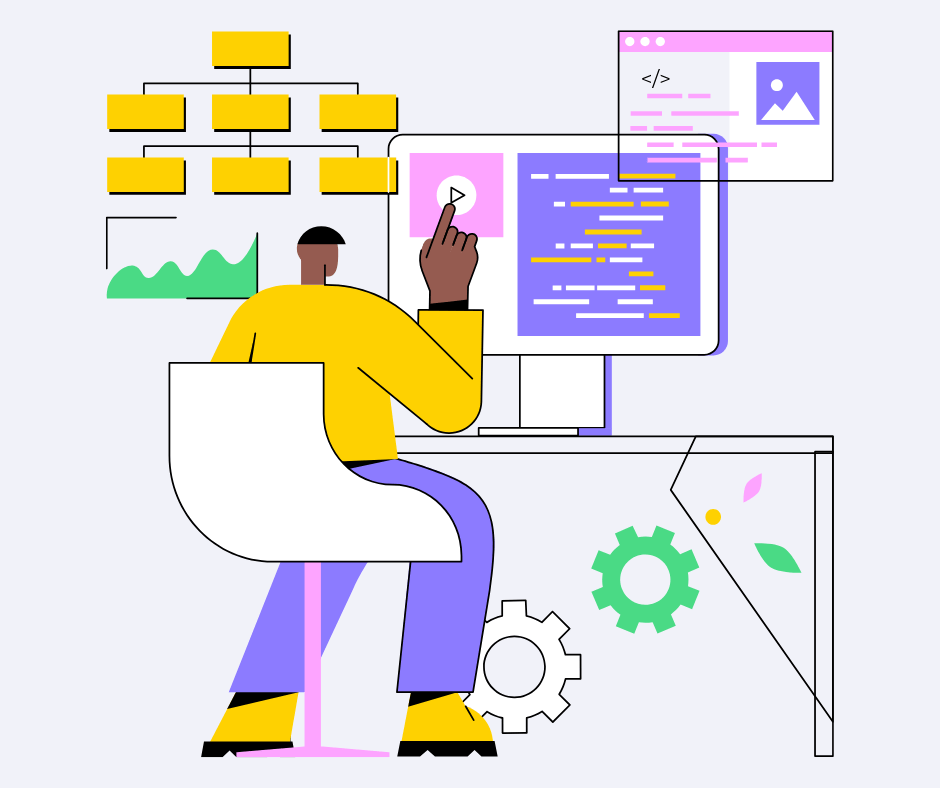In today’s fast-evolving digital landscape, businesses need flexible and scalable solutions to manage their content across multiple platforms. The demand for omnichannel experiences—where content flows seamlessly from websites to mobile apps, social media, smart devices, and even wearables—has increased dramatically. Traditional Content Management Systems (CMS) often struggle to keep up with this need for adaptability, scalability, and performance. Enter the Headless CMS: a modern approach to content management that offers unparalleled flexibility, speed, and scalability.
What is a Headless CMS?
A Headless CMS is a back-end-only content management system that decouples the front end (what users see) from the back end (where content is managed). Unlike traditional CMS platforms like WordPress or Drupal, where the back end and front end are tightly integrated, a Headless CMS focuses solely on content creation, storage, and management. It delivers content through APIs, leaving the presentation layer (how the content is displayed) to be handled by separate applications or websites.
In simple terms, in a traditional CMS, the “head” (front-end presentation layer) is attached to the “body” (content management system). In a headless CMS, the “head” is removed, and developers have the freedom to build any type of front-end experience they want, while the CMS handles only content delivery via an API.
How Does a Headless CMS Work?
A Headless CMS operates by delivering content via APIs (Application Programming Interfaces), typically RESTful or GraphQL. When content is created in a Headless CMS, it’s stored as raw data in the form of structured or unstructured content (like JSON, markdown, etc.). This content can then be fetched by any front-end framework or application through the API, which can render the content in whatever format or design the developers choose.
For example, with a Headless CMS:
- You might have a mobile app that fetches product descriptions from your CMS.
- A website might simultaneously pull the same content to display on a product page.
- An IoT device or a digital kiosk could pull this content to display in a different format.
This separation allows for faster performance, more flexibility in how content is presented, and easier integration with multiple channels.
The Traditional CMS vs. Headless CMS: Key Differences
To better understand the Headless CMS, it’s useful to compare it with the traditional CMS model:
| Feature | Traditional CMS | Headless CMS |
|---|---|---|
| Architecture | Monolithic, tightly coupled | Decoupled |
| Content Delivery | HTML/CSS directly to web pages | JSON/XML via API |
| Front-End Design | Tied to platform themes | Independent from CMS |
| Multichannel Support | Limited (mainly web-focused) | Omnichannel, supports web, mobile, apps, IoT devices |
| Customization | Limited to platform capabilities | Full flexibility with any front-end framework |
| Scalability | Limited due to monolithic nature | Highly scalable due to decoupling |
| Updates | Full stack needs updating | Can update front-end independently |
Why Choose a Headless CMS?
A Headless CMS comes with a host of advantages over traditional systems, especially for organizations that require flexibility, speed, and scalability. Let’s dive into the primary reasons why businesses and developers are shifting toward headless content management.
1. Omnichannel Content Delivery
Perhaps the biggest advantage of a Headless CMS is the ability to distribute content across multiple platforms simultaneously. In today’s world, users interact with businesses through websites, mobile apps, social media, chatbots, digital kiosks, and smart devices. With a Headless CMS, you can centralize content in one place and deliver it across these various platforms without having to duplicate efforts for each channel.
For instance, when launching a new product, you can create the content once and have it available on your website, mobile app, smartwatches, and even voice-activated devices like Amazon Alexa, all using the same API.
2. Increased Flexibility for Developers
One of the major pain points of traditional CMS platforms is that they limit developers to using built-in themes and templates, often slowing down the development process. With a Headless CMS, developers have complete freedom to choose any front-end technology or framework they prefer, such as React, Vue.js, Angular, or even static site generators like Gatsby or Next.js.
This flexibility allows for more innovative designs, better user experiences, and modern development workflows. Whether you’re building a website, mobile app, or any other digital interface, a Headless CMS integrates smoothly into your preferred stack.
3. Scalability
As your business grows, so too do your content needs. With traditional CMS platforms, scaling can be a challenge. When your traffic spikes or your content volume grows significantly, a monolithic architecture can strain under the load. Headless CMS platforms are cloud-based and designed to scale effortlessly. Content is delivered through APIs, which can handle large volumes of traffic and requests without compromising performance.
Additionally, because the front-end and back-end are separated, you can scale your front-end infrastructure independently of your CMS. This ensures faster performance even during high-traffic events like product launches or promotions.
4. Faster Performance
Headless CMS architectures deliver content via APIs, which means the front-end can be optimized for performance without being tied down by the back-end. This leads to faster load times for websites and apps. Additionally, static site generators like Gatsby or Next.js can be used to pre-render content, making websites even faster and more responsive.
For websites where speed is crucial for SEO and user experience, a Headless CMS offers a clear advantage. Reduced load times and faster delivery of content directly improve user engagement and search engine rankings.
5. Better Security
By separating the front-end from the back-end, Headless CMS systems inherently improve security. Traditional CMS platforms are often vulnerable to security breaches due to their monolithic nature, where plugins, themes, and third-party integrations create entry points for attacks. With a Headless CMS, the front-end and back-end are decoupled, reducing the potential attack surface.
Moreover, since a Headless CMS typically exposes only an API for content delivery, unauthorized users can’t directly access the CMS or its management interfaces, enhancing overall security.
6. Content Agility
For marketing teams, a Headless CMS provides a more agile way to manage content. Because content is stored separately from how it is presented, it’s easier to repurpose and reuse content across various channels. For example, a single article can be used on your website, app, and even formatted for a social media post, all from a central location.
This makes content management much more efficient and allows for faster updates. If you need to change a product description or update a blog post, it can be done in one place and reflected everywhere the content is used.
7. Future-Proofing Your Technology Stack
Technology trends come and go, and locking yourself into a specific front-end platform or CMS can hinder future growth. With a Headless CMS, you’re future-proofing your content infrastructure. You can easily swap out or update front-end technologies without affecting the CMS or content.
As new frameworks and front-end tools emerge, a Headless CMS provides the flexibility to evolve and adopt the latest innovations without having to rebuild your entire system.
Real-World Use Cases for Headless CMS
Many businesses across various industries are already taking advantage of the Headless CMS architecture. Here are a few real-world examples:
E-Commerce: Large e-commerce platforms often need to deliver content to their website, mobile app, digital kiosks, and IoT devices like smart mirrors. A Headless CMS allows for consistent content delivery and seamless integration across these platforms, while maintaining fast loading times and scalability during high-traffic events.
Media and Publishing: News organizations and media outlets need to distribute content across websites, mobile apps, social media, and even podcasts. A Headless CMS helps centralize content management and distribute it quickly and efficiently across multiple channels.
SaaS Companies: SaaS platforms frequently need to maintain a strong online presence, deliver customer support content, and provide resources like documentation, FAQs, and blog posts. A Headless CMS enables SaaS companies to manage this content in one place while delivering it to different user touchpoints seamlessly.
IoT and Smart Devices: As the Internet of Things continues to grow, businesses need to deliver content not just to traditional websites but also to smart devices like voice assistants, smartwatches, and connected home appliances. A Headless CMS allows businesses to manage this content efficiently and deliver it to a range of devices.
Challenges of Adopting a Headless CMS
While a Headless CMS provides a range of benefits, there are a few challenges that businesses might face when adopting this approach:
Requires More Development Resources: Since a Headless CMS decouples the front-end, you’ll need experienced developers to build the front-end from scratch or integrate with frameworks like React, Vue, or Angular.
Content Previewing: With traditional CMS platforms, you can usually preview content before it goes live on your site. With a Headless CMS, the decoupling makes this harder, though many modern solutions are beginning to introduce better preview options.
Choosing the Right Tools: The flexibility of a Headless CMS means you need to choose and configure various tools (for front-end, APIs, hosting, etc.) correctly. This can be time-consuming and require proper planning to ensure smooth integration.
Conclusion: Is a Headless CMS Right for You?
A Headless CMS is not just a buzzword—it’s a transformative approach to content management that offers tremendous advantages in terms of flexibility, scalability, and performance. For businesses that need to deliver content across multiple channels, handle large volumes of traffic, and future-proof their technology stack, a Headless CMS is a game-changer.
However, it’s important to assess whether your organization has the development resources and needs that justify the transition to a Headless CMS. If your content demands are simple and primarily web-focused, a traditional CMS might still be sufficient. But if you’re looking to scale, expand your digital reach, or innovate with new technologies, adopting a Headless CMS will enable you to stay competitive in today’s omnichannel world.
The future of web development is moving toward greater flexibility and scalability, and a Headless CMS is at the forefront of this evolution. It’s time to think beyond the “head” and embrace a more agile, future-proof content strategy.




